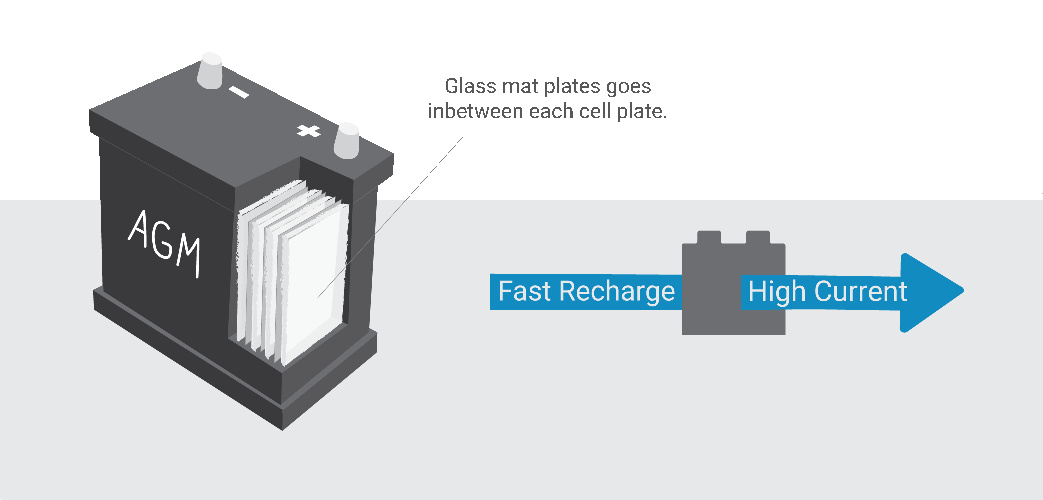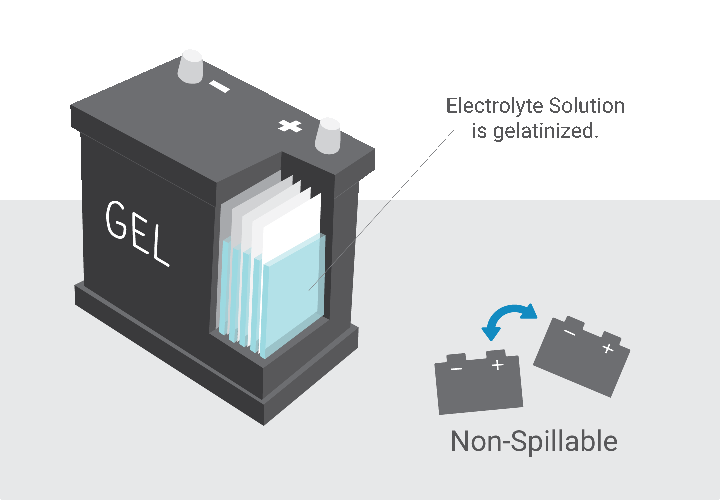
AGM (absorbent fiberglass mat) and gel batteries are examples of VRLA (valve regulated lead acid) batteries. They are also called SLA (sealed lead acid) batteries. These abbreviations refer to the safety valve in the battery cover. Generally speaking, the term gel battery is used to mean AGM and gel battery. AGM batteries can also be called “membrane”, “starved electrolyte” or “dry” batteries.
AGM batteries are often mistaken for gel batteries. Although AGM and GEL battery may have similar characteristics; for example, non-spillable, both are deep-cycle batteries, which can be installed in any position, have low self-discharge rate, are safe to use in limited ventilated areas, and can be passed safely Air or ground transportation without special handling.
We will introduce in this article some very obvious differences between AGM and GEL battery types. Let’s compare the differences and similarities to help determine which battery is best for your power application.
There are two different versions of VRLA batteries: AGM batteries and gel batteries. In gel batteries, certain elements—usually a specific silicon mixture—are added to the battery acid to convert the electrolyte into a gel-like substance that it doesn’t leak. By “drilling” channels in the gel, gaseous oxygen moves from the positive plate to the negative plate. Here it encounters hydrogen and recombines into water, releasing energy. Gel batteries have excellent capacity, but their acid resistance is slightly increased, so they are not suitable for starting batteries. They are highly resistant to excessive deep discharge and can maintain their function even when the battery is discharged to 20% of its nominal capacity.
In AGM (absorption glass mat) batteries, the electrolyte is held in place by a separator. This is the reason that these batteries are also called membrane batteries. The membrane is composed of a glass fiber mat, which acts as a sponge. This function is based on the capillary properties of the membrane. AGM batteries can be produced using very thin separators, resulting in low internal resistance. This means that a relatively small size battery can be used to achieve high output power, making this type of battery an ideal choice for wide range applications.
AGM technology stands for absorbent glass mat. This explanation sounds ridiculous, but it is very suitable. Absorbent glass mat refers to a thin glass fiber mat that can absorb sulfuric acid and make the battery splash-proof. Doesn’t it make more sense now? In the 1980s, there was an increasing demand for lighter, less harmful batteries that can be used in airplanes and vehicles.
AGM technology can meet this demand. Suddenly, the battery can be transported without the problem of hazardous materials, and the structure of the mat means that the battery can now be molded into a cylinder or a traditional rectangular cube.

GEL technology is another matter entirely. A gel battery is a battery that uses sulfuric acid mixed with fumed silica to produce an immovable gel-like substance. Because of the gel battery, the battery does not have to be kept upright, and electrolyte can flow between the plates without overflowing.
These batteries produce very little smoke, so they are very suitable for use in poorly ventilated areas.
It is known that we have a better understanding of them, let us compare them.

Although AGM and Gel battery is different, there are some similarities that cause people to confuse both of them. They are non-spillable, deep-circulating (meaning they can be discharged deeply), and can be transported safely. So what makes them special?
• AGM
– It is best used when a large amount of current is required.
– Can last for several years.
– Can be easily charged, in some cases up to 5 times.
– At a lower cost than gel batteries.
– Has low internal resistance.
– Performs well at temperatures below 32 degrees.
• Gel
– Lower power capacity.
– Perform well in a warm environment.
– Suitable for slow discharge rate.
– If the charging is incorrect, the battery will malfunction before the end of its life cycle.
– Due to the increased acid resistance, it is not suitable for use as a starting battery.
– Poor performance at temperatures below freezing.

1. What purpose do you use the battery for?
2. Does the battery have to work at a temperature below freezing point?
3. How will you charge the battery?
4. Do you need a slow discharge speed or explosive power?
Once you have the answers to all of these questions, you can determine the best battery for you. For the climate warming and you need lower emission rates? AGM and gel battery may be the answer.
If the climate is cold, do you want to use the battery as a starting battery? Of course, Springing for the gel battery may just be the answer. By knowing the battery you buy is a great help in preventing equipment damage and extending battery life.
All in all, in terms of durability, long life and charging, AGM battery sales surpassed gel types. They are also cheaper and can work in different weather conditions.
Compared with AGM batteries, gel batteries have a lower leakage percentage due to their gel composition. Hope everyone know the differences and similarities between AGM and GEL battery now, and hope this article can help you to determine which battery is best for your power application.